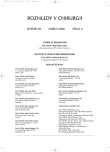-
Medical journals
- Career
Diagnosis and Treatment of Liver Injuries
Authors: V. Třeška *; T. Skalický *; V. Šimánek *; K. Houdek *; J. Chvojka *; J. Ferda **
Authors‘ workplace: Chirurgická klinika FN a LF UK v Plzni, přednosta prof. MUDr. V. Třeška, DrSc. *; Radiodiagnostická klinika FN a LF UK v Plzni, přednosta doc. MUDr. B. Kreuzberg, CSc. **
Published in: Rozhl. Chir., 2006, roč. 85, č. 4, s. 159-162.
Category: Monothematic special - Original
Overview
Aim:
The aim is to specify contemporary diagnostic and therapeutic procedures of liver injuries.Methodology:
The authors present a trial group of 117 patients with various stages of liver injuries hospitalized at the Traumacentrum Surgical Department of the Faculty Hospital in Plzeň from 1. 1. 2000 to 31. 9. 2005. 61 injured (52.1%) were treated conservatively, 56 (47.9%) surgically, who underwent 87 procedures, in total.Results:
10 polytrauma patients exited (8.5%) from a haemorrhagic shock (group Moore IV-VI). Six subjects (5.1%) had complications on hospitalization. Average hospitalization lasted 18 days (1–69 days).Conclusion:
The basic diagnostic tools in liver injuries include „bed side“ ultrasonography, spiral computer tomography, in more complicated traumas also MRI, angiography or endoscopic retrograde cholangiography. As a treatment strategy, conservative methods prevail in haemodynamically stable patients, regardless of the liver injury stage. The objective of the surgical management is to provide „damage control surgery“, i.e. the first procedure is aimed at life-saving, no time-demanding surgical procedures (e.g. liver tamponade), management of hypothermia, haemocoagulation and metabolic acidosis.Key words:
liver injury – diagnosis – treatment strategy
Labels
Surgery Orthopaedics Trauma surgery
Article was published inPerspectives in Surgery

2006 Issue 4-
All articles in this issue
- Re-laparotomy for Complications of Urgent Abdominal Disorders
- Paliative Managment of Oesophageal Carcinomas – Our Experience
- Rare Cases of Acute Urineous Peritonitis as a Consequence of a Spontaneous Rupture of the Urinary Bladder
- Diagnosis and Treatment of Liver Injuries
- Prognostic Factors of Early Recurrence of Colorectal Liver Metastases and Their Usage in Clinical Praxis
- A Prospective Clinical Feasibility Study for Multimodal „Fast Track” Rehabilitation in Elective Pancreatic Cancer Surgery
- The Prepancreatic Course of Superior Mesenteric Vein – a Case Report
- Perspectives in Surgery
- Journal archive
- Current issue
- Online only
- About the journal
Most read in this issue- Re-laparotomy for Complications of Urgent Abdominal Disorders
- Rare Cases of Acute Urineous Peritonitis as a Consequence of a Spontaneous Rupture of the Urinary Bladder
- Paliative Managment of Oesophageal Carcinomas – Our Experience
- A Prospective Clinical Feasibility Study for Multimodal „Fast Track” Rehabilitation in Elective Pancreatic Cancer Surgery
Login#ADS_BOTTOM_SCRIPTS#Forgotten passwordEnter the email address that you registered with. We will send you instructions on how to set a new password.
- Career

